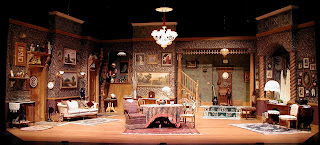The Dada movement began in the early 20th century in Switzerland after the influences of World War I. Dadaism embraced the lack of logic and sense and focused on irrationalities and intuitions. The movement was focused in art, theater, poetry, literature, sound poems, manifestos and more.
One of the main artists of the Dadaism movement is French artist Marcel Duchamp. Duchamp was and still is considered by many to be one of the most important artists of the early 20th century due to not only his Dadaism art, but his futuristic pieces as well! Shown below are some examples of his work.
This piece of art is Duchamp's "Fountain" which is actually a urinal!
This next piece is nothing more than a bicycle wheel and stool. Found objects that he proclaimed as art!
Another important artist of the Dadaism movement is German artist and architect Johannes Baader. His main medium of Dada art was through the making of visual collages and things of that nature. Check some of this stuff out!
A very influential Dada poet of the time is a man by the name of Tristan Tzara. Bellow is poem titled "To Make a Dadaist Poem".
To Make A Dadist Poem
Take a newspaper.Take some scissors.
Choose from this paper an article the length you want to make your poem.
Cut out the article.
Next carefully cut out each of the words that make up this article and put them all in a bag.
Shake gently.
Next take out each cutting one after the other.
Copy conscientiously in the order in which they left the bag.
The poem will resemble you.
And there you are--an infinitely original author of charming sensibility, even though unappreciated by the vulgar herd.
You can see the embrace of the lack of logic in the piece above.
''Dada doubts everything. Dada is an armadillo. Everything is Dada, too. Beware of Dada. Anti-dadaism is a disease: selfkleptomania, man's normal condition, is Dada. But the real dadas are against Dada.'' - Tristan Tzara.
Tzara wasn't only a very influential poet. He was also the self proclaimed "leader of Dada". He was also responsible for writing many Dadaistic plays.
Below is a 10 minute video containing a lot of interesting facts about Dada.
The video starts with a staccato of the word Dada repeated many times with a long string of Dadaistic images. The starting of the video definitely sets itself up to be a Dada video.
Below is a modern rendition of a Dada sound poem. One would defiantly need to listen to this poem to understand its Dadaistic nature.
Below is another Dada sound poem.
The Dada movement may have been short lived and highly criticized, but like all art, it became a wonderful refuge for many artists with a need to express their feelings, thoughts, and emotions. Though the Dada movement is considered long dead by many people, there are still a few true "Dada" artists today.









